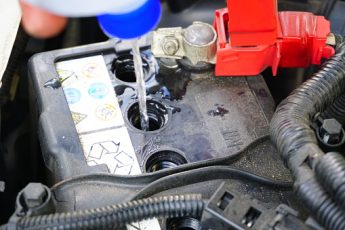Humans are not the only ones who need water to survive; even machines do. After a long, hot day, a bottle of water would refresh and stabilize the body; the same works for machines too. Cars don’t only need fuel to work, but also water to be at their best performance. The Lead Acid Battery often needs to be maintained for safety, and water plays a huge role in its electrochemical equation.
When adding water to a car battery, you need to be careful not to damage it – overwatering and underwatering aren’t good. Thus, this article aims to provide you with steps and tips on keeping a car battery hydrated successfully.
How to Add Water to Car Battery: Step by Step Guide
Quick Navigation
There are things you must do to ensure the procedure of watering a car’s battery goes smoothly. Besides, how often you water depends on how you use the battery.
Check Water Battery Levels
One of your sole responsibilities as a car owner is to protect the battery life of your car. A good way to do that is to make sure it is properly hydrated to function efficiently. Interestingly, they are maintenance-free, so you shouldn’t have much to do. With the inbuilt indicator, you can check the water battery level to know when next to hydrate.
If you don’t know how to read these levels – Electrolyte will be out of balance for low water levels. Its battery cells also become acidic due to the sulphation of battery plates. On the other hand, the electrolyte will be in a good position, showing enough water for safety.
Wear Protectives
If the situation calls for you to add water, well, you might want to be careful with the process. Different things could go wrong. First, ensure that the engine is turned off before anything else. Next, open the hood and find the battery. With the battery in sight, read warnings on whether the vent caps could be opened or not. If it can, locate the vent caps and pop them open.
While you are doing this, you should consider your safety by wearing protectives. Gloves and eyewear are perfect for hazard-free operation‘
Add Water
Now that you know that your car battery needs water, the next step is adding one. Before you do that, distilled water is the only acceptable type of water. Try not to use tap water because it contains minerals that damage the battery’s life slowly.
You must water the battery only if you are convinced that it is fully charged. If it isn’t charged, make sure there is a little amount of water that would cover the exposed plates while it is charging. Then, add water but do not over-water or under-water.
Moreover, batteries contain liquid electrolytes made of sulfuric acid and water. In the process of charging, hydrogen and oxygen gases are released. Overall, the battery’s health and safety are dependent on the careful procedures taken.
What Happens When You Add Little/Too Much Water to a Battery?
High and Low water levels in a car battery are not good. You will find yourself spending on repair, maintenance, and even a new battery if you are not careful. When you add too much water, the Lead acid battery’s electrolyte will expand, making the battery overflow. Ultimately, the battery gets destroyed, and you will have to get a new one.
On the other hand, low water levels would affect the electrolyte, making them unstable with the battery cells become acidic. The instability and acidity of these components cause the battery plates to sulphonate.
In essence, when adding water to battery, you should try to maintain a balance – be neutral, i.e., not too acidic and not too alkalic.
How Often Should I Add Water to Battery?
You shouldn’t be too concerned with how often you should add water to a car battery; instead, be intentional about checking water levels. For a new battery, once or twice every two to three months isn’t bad; for older batteries, you should check once every week. With that, you will know when to add water.
How Do You Know You Need a New Car Battery?
There are circumstances where the battery water level may not give up why a car refuses to start. On many occasions, people blame it on fuel or spark issues; however, running a diagnostic check is important. In some cases, it could be that the battery is already damaged and needs replacement.
Unfortunately, not many car owners can tell when they need a new battery or not; hence, the following steps would help you determine whether a car battery is good or not.
- Battery Inspection
Knowing the situation of your battery means checking from where it all starts – the hood. Open the hood of your car, and locate the battery. Ensure that the battery is connection-free by inspecting; check every side and corner to ensure the battery is not deformed. Bad battery cells often show signs like swollen sides, meaning you would need to buy another battery. Also, make sure the wires are left unexposed; you need new wiring sets if they are.
- Open the Caps
If, after inspection, you don’t see anything wrong, proceed to open the caps. An unsealed unit can be opened with a screwdriver. Check water levels and fill if necessary. Following that, tighten the caps and try to start the car.
- Connections Test
Another thing you are left with is doing a wire connection test. With an open-end wrench, ensure that the battery leads are properly connected to the terminals; however, do not overrun the leads. Additionally, you can retest the battery’s voltage with an ohmmeter to know whether the alternator or the battery is damaged.
Read on alternator vs battery here‘.
Conclusion
Every day, people complain of car batteries becoming faulty or damaged; most times, there is little or no effort to preserve battery life. However, this article has emphasized adding water to car battery as a means of ensuring proper maintenance, health, and safety; therefore, you should take heed before it is too late.

